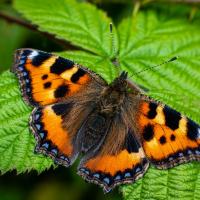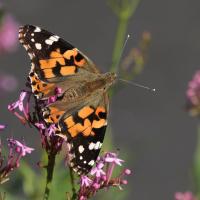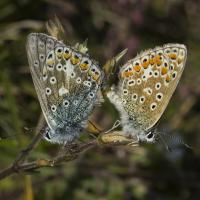Butterflies are known as excellent "environmental indicators" - responding to changes in their environment very quickly with increases or decreases in their population. In general, a diverse habitat with many different plant species will support a wider range of butterflies. The British Isles are home to 59 species, 57 of which are resident, plus 2 migrants (the painted lady and clouded yellow), but only some 19 of them are found on the Isle of Man.
All species share the same four life-stages - egg, caterpillar, pupa and adult. However, each species usually has some specific requirements for habitat, food and climate if to breed and survive. The absence of one or more of these factors will explain why those 40 other species are not found on the island. Key requirements include food for the caterpillar, sometimes just one particular plant being favoured, though most species can feed on a variety of food sources. Technically, once into the adult phase, the adults don't feed - they drink via their proboscis (a long tube extending from the head). Whilst nectar is an important food source providing energy, other products such as muddy water, rotten fruit and even animal carcasses will provide essential minerals and salts. Another requirement is access to warmth - butterflies are cold blooded and have no means to regulate their body temperatures, so a warm, south facing slope or bare earth will provide favourable conditions in which to bask, warm up and then to fly. If it is too cold, the butterfly will be immobilised - so spreading their wings allows the small capillary blood vessels in the wings to heat up and thus enable flight. And finally, our resident butterflies obviously over-winter so need a safe environment to survive. Usually, most of our resident species over-winter in the form of caterpillars, sheltering in vegetation, and some as pupae (the chrysalis stage), but 4 of the Manx species over-winter in the adult form (the comma, peacock, small tortoiseshell and red admiral) and turning on your central heating may be enough to wake them up!
Thus, with the small tortoiseshell overwintering, it is no surprise that it may be seen at almost any time of the year - the image here is by Steve Johnstone. The painted lady, in an image by Beryl Quayle, is one of our early arrivals, and astonishingly, is a migrant from North Africa arriving in April and staying with us until early autumn before its return journey. The common blue arrives rather later and is to be found in a variety of grassy habitats, often coastal dune areas such as the Ayres. The males have distinctive bright blue upper wings whilst in the female , these may vary from mainly brown to mostly blue, with orange "eyelets" at the rear. Both male and female undersides are similar as can be seen in the image by Sue Jones.
The Society's programme of meetings remains in abeyance as a result of the latest Covid outbreak. Please check our website www.iomps.com or our Facebookpage for any update to the scheduled meetings.
The Isle of Man Photographic Society is supported by the Arts Council
Chris Blyth
CAPTIONS:
IMAGE 01: Small Tortoiseshell by Steve Johnstone
IMAGE 02: Painted Lady by Beryl Quayle
IMAGE 03: Common Blue (male and female) by Sue Jones



